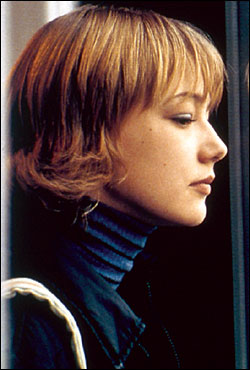JANE CAMPION’S FILMSSweetie, The Piano, The Portrait of a Lady, and Holy Smoke among themare never ordinary, never alike, never without controversy. With In the Cut (which opens Friday, Oct. 31, at Metro and other theaters), Campion moves into new territory, turning this hard-edged world of detectives and serial killers inside out so we see it through a woman’s eyeson both sides of the camera. The movie is likely to infuriate and enthrall, probably more the former than the latter. Yet even when it veers indefensibly out of control, consider me enthralled.
With passing nods to Klute, Cut is built on stalker underpinnings; it can also be seen as a dangerous modern love storya cautionary tale about trusttold elliptically, even messily, with shimmering visual layers and a cool matter-of-factness to its hot sex. The film is based on Susanna Moore’s erotic 1995 thriller, and Campion has always understood that real eroticism begins in the mind. (In The Piano, she got more voltage from a dime-sized glimpse of ivory skin beneath a black cotton stocking than all the flesh laid bare in Showgirls.)
So instead of finding acrobatic new ways to photograph bodies faking sex, Campion locates the real reason that Malloy (Mark Ruffalo), an N.Y.C. homicide detective, gets to Frannie Avery (Meg Ryan), an N.Y.U. prof: It’s not just the sex, it’s how he talks about sexand everything elsethat turns on this emotionally becalmed academic who’s so in love with the power of language. When he tells her he’ll do anything she wants (short of beating her up), he doesn’t lower his voice because it’s dirty; he’s direct and unembarrassedpart of what makes him a very good lover. That still leaves the matter of trust, which is a little more iffy.
The two meet not long after Frannie blunders onto a blow job in progress in the dark recesses of a seedy bar. She’s fairly sure the shadowy man has seen her in the doorway, from the way he sweeps aside the girl’s long red hair as if to give Frannie a better look. Before her stunned retreat, she has time to notice a tattoo inside his wrist: the three of spades. When that same redhead is found murdered only hours later, the investigation brings Malloy, calm and appraising, to Frannie’s apartment building. Within days, they’re into a steamy affair, although certain details she picks up on (in addition to his now familiar tattoo) make her afraid he may be the killer. (And more victims do follow.)
IT’S NOT HARD TO SEE why Malloy entices Frannie. Having withdrawn into her work, she has only her half-sister Pauline (Jennifer Jason Leigh) to share the intimate stuff of her life, and Pauline is truly, magnificently messed up. If Frannie’s creepy ex-boyfriend (Kevin Bacon) isn’t the serial killer, he’s a serial annoyance; meanwhile, the brightest of her students (Sharrieff Pugh) is fixated upon defending John Wayne Gacy. So while Malloy may be risky, he’s not the most dangerous game in this new jungle.
Frannie and Pauline are muzzy mirror images of each other, each working out her abandonment by a father who’s walked away from five wives and counting. Pauline clings to men, with crazy, obsessive fantasies that keep her from any real relationship. Frannie, instinctively more aloof and wary of men, finds every reason to mistrust Malloy. (In their scenes together, the soft, brilliant interplay between these two actresses leaves you wondering when it was that casting Leigh, a complex, exquisite actress, became the shorthand for “victim.”)
Campion’s greatest success in Cut comes from the utter honesty of Ryan’s and Ruffalo’s work. (Leigh has already made a career out on this dangerous edge.) Stripped of any need to be lovable, Ryan is unguarded, open, a brave mixture of damage and optimism. Ruffalo obliterates his bruised little-boy persona to make the enigmatic Malloy not just compelling but worthy of every lickerish look he’s likely to get.
God knows this film vacillates between poetic moments, like the “petal storm” that introduces us to Pauline and Fannie, and mortifyingly literal symbolism, like the recurring red lighthouse (for Fannie’s English class on Virginia Woolf and, I fear, for Fate). And no one would be mad enough to defend the last long sequence: Campion must simply have thrown up her hands and tossed logic into the Hudson River.
Lovers of the novel may miss Moore’s shocking conclusion, but as Campion said stoutly on The Charlie Rose Show last week, she’s too much of an optimist for that. In this respect, In the Cut may very well be a triumph of illogic, but I’d rather see Campion, passionate about passion, coming down foursquare on the side of trust than feel nothing while watching nearby screens where bodies pile up like chic cordwood.








